Overhead marathon photography captivates you by transforming a grueling race into a mesmerizing visual spectacle. From above, you'll see thousands of runners creating dynamic patterns and shapes as they navigate the course. The bird's-eye view reveals the sheer scale of the event, highlighting the contrast between urban landscapes and the organic flow of athletes. You'll witness the ebb and flow of the race, from tightly packed groups to fragmented lines, telling a unique story of human endurance and collective energy. This perspective offers insights into race dynamics and individual struggles that aren't visible from ground level. Exploring this aerial artform will disclose even more fascinating aspects of marathon photography.
Bird's-Eye View of Human Endurance
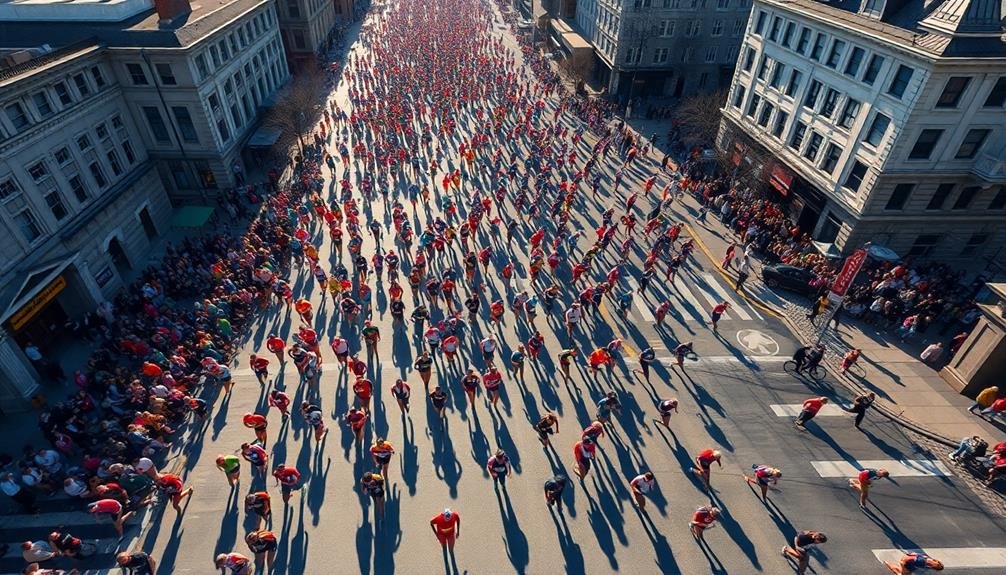
Soaring high above the bustling streets, overhead marathon photography captures the raw essence of human endurance. You'll witness a sea of runners, each a tiny dot in a vast landscape, yet collectively forming a powerful image of determination.
From this vantage point, you can observe the ebb and flow of the race, as packs of runners bunch together and spread apart. You'll notice the stark contrast between the urban environment and the organic movement of athletes. Skyscrapers and city blocks create a geometric backdrop for the winding river of participants.
The bird's-eye view reveals the true scale of the event, showcasing thousands of individuals united in a common goal. This perspective also highlights the course's challenges. You'll see runners tackling steep inclines, maneuvering sharp turns, and pushing through long straightaways.
The overhead shots capture pivotal moments: leaders breaking away from the pack, stragglers persevering, and the final sprint to the finish line. It's a unique way to appreciate the physical and mental strength required to complete a marathon, offering insights into the human spirit that ground-level photography simply can't provide.
Patterns in Motion
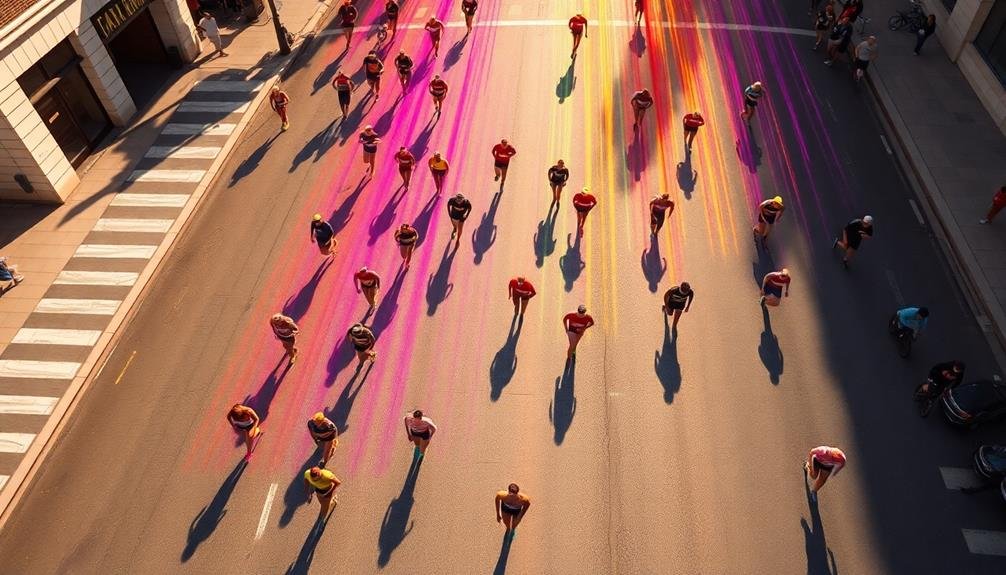
A mesmerizing aspect of overhead marathon photography is the revelation of patterns in motion. As you observe these aerial shots, you'll notice the rhythmic flow of runners creating dynamic shapes and lines across the landscape. The repetitive motion of thousands of athletes forms intricate patterns that aren't visible from ground level.
You'll see serpentine curves as runners navigate winding roads, or perfect parallel lines as they stride down straight boulevards. In crowded sections, you might spot a "braided" effect as runners weave around each other. At water stations, you'll observe clusters forming and dispersing, creating temporary hubs of activity.
The patterns change as the race progresses. Early on, you'll see tightly packed groups moving as one unit. As the marathon unfolds, these groups stretch and fragment, creating a more scattered visual rhythm.
You'll also notice color patterns emerging from the runners' attire, adding another layer of visual interest to the scene.
These patterns in motion tell the story of the race's ebb and flow, revealing the collective journey of human endurance in a uniquely enchanting way.
Scale and Perspective Challenges

Overhead marathon photography presents unique scale and perspective challenges for photographers. You'll need to take into account the vast distance between your camera and the runners, which can make individual participants appear tiny. This scale difference requires careful planning to guarantee you capture enough detail while still showcasing the event's magnitude.
You'll face the challenge of conveying depth in a two-dimensional image. From above, the course may appear flat, so you'll need to use creative techniques to add dimensionality. Try incorporating shadows, landmarks, or varying terrain to create a sense of depth and context.
Lens choice becomes vital. Wide-angle lenses can capture more of the scene but may distort the image edges. Telephoto lenses can compress the scene, making runners appear closer together than they actually are. You'll need to experiment to find the right balance for your desired composition.
Weather conditions can also affect your perspective. Clouds, haze, or bright sunlight can alter visibility and contrast. You'll need to adapt your settings and timing to overcome these environmental challenges and capture clear, compelling images of the marathon from above.
Capturing Collective Energy
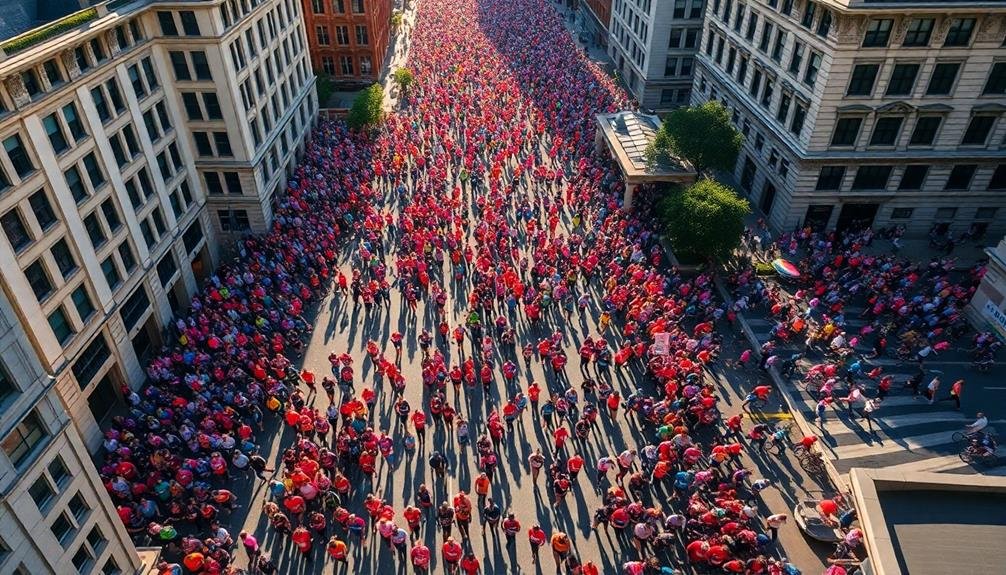
When photographing marathons from above, you'll witness the fascinating mass movement dynamics of runners.
You can capture the synchronized human flow as participants move in unison along the course.
Your images will showcase the collective energy of thousands of individuals working towards a common goal, creating a visual spectacle of human endurance and unity.
Mass Movement Dynamics
Marathon crowds pulsate with collective energy, creating a visual spectacle that's ripe for overhead photography. From above, you'll witness the ebb and flow of runners as they navigate the course, forming intricate patterns that evolve with each passing moment.
This bird's-eye view reveals the true scale and dynamism of the event, allowing you to capture the essence of mass movement in a single frame.
As you shoot, you'll notice how the crowd's movement resembles natural phenomena:
- Runners bunch up at bottlenecks, like water rushing through a narrow channel
- The pack stretches out on straightaways, reminiscent of a flowing river
- Colorful clusters of athletes form and disperse, mimicking schools of fish
- Leaders break away from the main group, creating ripples of movement behind them
These mass movement dynamics offer endless opportunities for compelling shots.
You'll capture the interplay between individual runners and the collective whole, showcasing both the personal struggles and the shared experience of the marathon.
Synchronized Human Flow
Occasionally, marathon crowds exhibit a mesmerizing synchronicity that's perfect for overhead photography. You'll notice runners moving in unison, creating patterns that resemble flowing water or migrating birds. This synchronized human flow captures the collective energy of the event, making for stunning aerial images.
As you frame your shot, look for moments when runners naturally align. You'll often see this at the starting line, water stations, or when maneuvering turns. The visual impact is heightened when participants wear similar colors or when sunlight creates long shadows.
To capture this phenomenon effectively, consider these factors:
| Timing | Equipment | Technique |
|---|---|---|
| Dawn/Dusk | Drone | Wide-angle lens |
| Start/Finish | Helicopter | Time-lapse |
| Turns | Elevated Platform | Slow shutter speed |
| Aid Stations | Tall Building | Panoramic stitching |
Unique Storytelling Opportunities
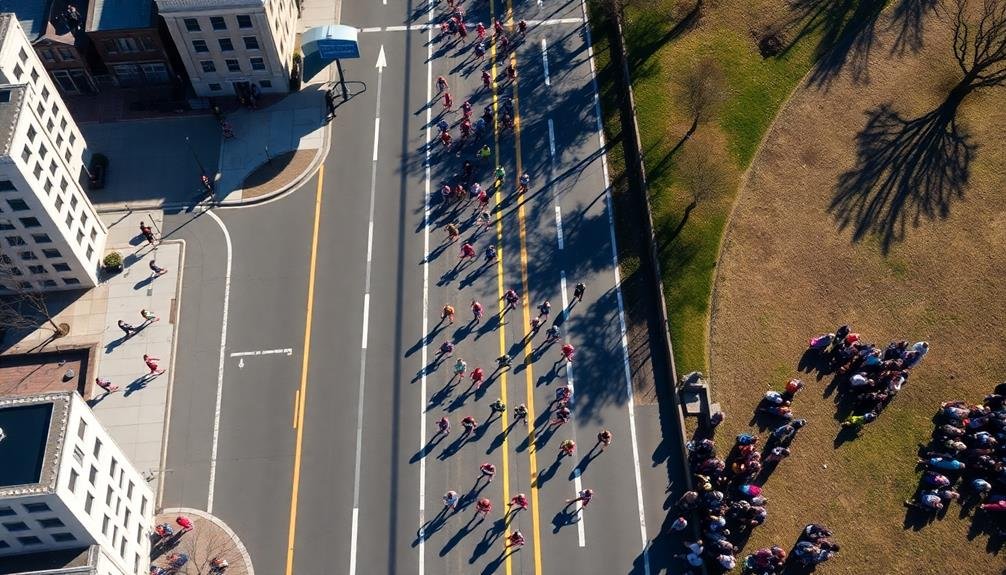
Overhead marathon photography offers you unparalleled opportunities to capture runners' journeys from start to finish.
You'll be able to showcase individual stories of triumph, struggle, and perseverance as participants wind their way through the course.
From this vantage point, you can also reveal the complex dynamics of the race, including pack formations, breakaways, and the ebb and flow of leaders throughout the event.
Capturing Runner's Journeys
From high above, photographers have a unique vantage point to capture the emotional journey of marathon runners. You'll see the entire story unfold, from the anticipation at the starting line to the triumphant finish. Overhead shots reveal the ebb and flow of the race, showcasing the determination and struggle of each participant.
As you zoom in on individual runners, you'll capture their personal narratives:
- The seasoned athlete, effortlessly gliding through the course
- A first-timer, visibly pushing through their limits
- Friends running side-by-side, offering encouragement
- A runner stopping to help a fallen competitor
These moments, often missed at ground level, become powerful storytelling elements from above. You'll document the changing expressions, body language, and interactions that reflect the runners' inner battles and victories.
The bird's-eye view also allows you to contextualize each runner's journey within the larger event, showing their progress relative to others and the cityscape around them. By capturing these diverse experiences simultaneously, you create an all-encompassing visual narrative that resonates with viewers and celebrates the human spirit of endurance.
Revealing Race Dynamics
Aerial photography opens unique storytelling opportunities by revealing race dynamics invisible from the ground. You'll capture the ebb and flow of the race, showcasing how runners bunch together, spread out, and navigate the course. From above, you can document lead changes, breakaways, and the formation of pace groups.
Overhead shots allow you to highlight the race's scale, showing thousands of participants moving as one entity. You'll reveal how the pack stretches and contracts at different points, offering insights into the race's rhythm and flow.
Here's a table showcasing what you can capture from above:
| Race Dynamic | What It Reveals |
|---|---|
| Pack Density | Competitive intensity |
| Lead Changes | Race strategy |
| Course Bottlenecks | Logistical challenges |
| Pace Groups | Collective effort |
| Breakaways | Individual performance |
Technical Aspects of Aerial Photography
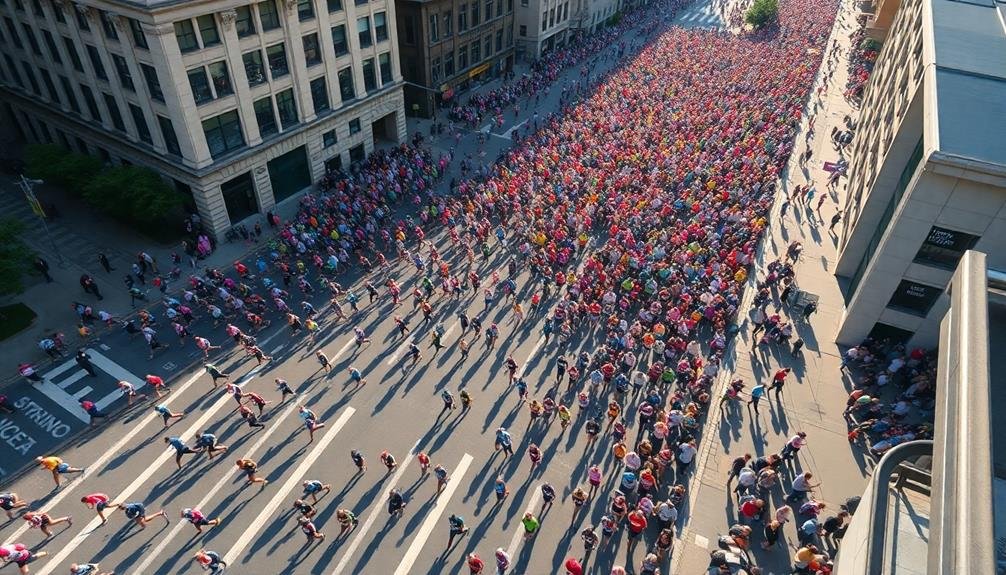
Capturing marathon events from above presents unique technical challenges for photographers. You'll need specialized equipment and expertise to achieve those stunning aerial shots. High-resolution cameras with wide-angle lenses are essential to capture the scope of the race. You'll also want to take into account using drones or helicopters for elevated perspectives.
When shooting from the air, you must account for vibration and movement. Image stabilization technology becomes vital in maintaining sharp, clear images. You'll need to adjust your camera settings for faster shutter speeds to freeze the action below. It's also important to plan your shots in advance, reflecting on the race route and key locations.
Here are some technical aspects to keep in mind:
- Proper permits and clearances for aerial photography
- Weather conditions and lighting challenges
- Communication systems between ground crew and aerial team
- Post-processing techniques for enhancing aerial images
As you master these technical aspects, you'll be able to create compelling overhead marathon photos that showcase the event's scale and energy.
Remember to prioritize safety and adhere to local regulations while pushing the boundaries of your aerial photography skills.
Frequently Asked Questions
How Do Photographers Obtain Permits for Overhead Marathon Shots?
You'll need to contact the marathon organizers and local authorities to obtain necessary permits. They'll often require proof of insurance, safety plans, and equipment details. It's essential to start this process well in advance of the event.
What Are the Safety Precautions for Drones During Marathon Photography?
When you're using drones for marathon photography, you'll need to follow strict safety guidelines. Keep your drone within sight, avoid flying over crowds, maintain a safe distance from runners, and always adhere to local regulations and event restrictions.
How Does Weather Affect Overhead Marathon Photography?
You'll find weather greatly impacts your overhead marathon photography. Rain can blur images and damage equipment. Wind affects drone stability. Sunlight influences exposure and shadows. Cloudy conditions may provide softer, more even lighting for your shots.
Are There Specific Marathon Events Known for Spectacular Aerial Shots?
You'll find stunning aerial shots at iconic marathons like New York City, Boston, and London. These events offer breathtaking city landscapes, massive crowds, and historic landmarks. The Great Wall Marathon in China also provides unique overhead perspectives.
How Do Runners Feel About Being Photographed From Above During Marathons?
You'll find most runners enjoy aerial photos during marathons. You're part of a larger spectacle, and it's exciting to spot yourself later. You might even feel motivated knowing you're being captured from above.
In Summary
You've seen how overhead marathon photography reveals the epic scale of human endurance. It's transformed runners into living art, showing patterns you'd never spot from the ground. You've grasped the technical challenges and storytelling power of this unique perspective. Next time you see an aerial shot of a marathon, you'll appreciate the photographer's skill in capturing not just an event, but a collective human spirit in motion.

As educators and advocates for responsible drone use, we’re committed to sharing our knowledge and expertise with aspiring aerial photographers.




Leave a Reply